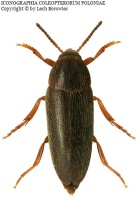Підтримуємо Вільну Україну
 We Support Free Ukraine
We Support Free Ukraine

Biodiversity Map
Taxa

Taxon count: 4
-
Arthropodaphylum
Click to switch
to select orders
and filters > -
Hexapodasubphylum
Click to switch
to select orders
and filters > -
Insectaclass
Click to switch
to select orders
and filters > -
Coleopteraorder
Click to set
as the main taxon
and as a base
← of the left panel > -
Polyphagasuborder
Click to set
as the main taxon
and as a base
← of the left panel > -
Cucujiformiaseries
Click to set
as the main taxon
and as a base
← of the left panel > -
Tenebrionoideasuperfamily
Click to set
as the main taxon
and as a base
← of the left panel > -
Melandryidaefamily
Click to set
as the main taxon
and as a base
← of the left panel > -
Melandryinaesubfamily
Click to set
as the main taxon
and as a base
← of the left panel > -
Dircaeinitribe
Click to set
as the main taxon
and as a base
← of the left panel > -
Anisoxyagenus
Click to set
as the main taxon
and as a base
← of the left panel >
species:
Anisoxya fuscula
PL
YES
name status: valid name
BioMap ID: 1020672
taxon code: 3769
taxonomy checked: YES
Polish Red List: DD
Data on distribution in Poland

Statistics
- Records: 73
- Publications: 30
- Collections: 10
- Publication authors: 30
- Illustrations (iconography): 1
- Photos (specimen/observation): lacking
Taxon description
Gatunek środkowoeuropejski, na północ docierający do Danii, południowych części Anglii i Szwecji, a na południe do Włoch północnych, Chorwacji i Gór Bihorskich w Rumunii. W Polsce znany z nielicznych stanowisk tylko w czterech krainach. Na podstawie rewizji zbiorów zostało stwierdzone (B. Burakowski*), że omawiany gatunek był wykazany omyłkowo z Pobrzeża Bałtyku (Lüllwitz 1916) na podstawie błędnie oznaczonych dwu okazów Scraptia fuscula Ph.W.J. Müll. oraz z Ojcowa (Tenenbaum 1923) na podstawie błędnie oznaczonego okazu Hallomenus binotatus (Quensel). Spotykany rzadko i sporadycznie z powodu skrytego sposobu życia. Znajdowany głównie w suchych gałęziach różnych drzew liściastych, zwłaszcza dębu, buka, topoli i wierzby. Chrząszcze z ukrycia wychodzą dopiero o zmroku.
Illustrations
... browse
 Anisoxya
Anisoxyafuscula
External data sources
- Ostatnie rekordy
-
1077409
 ⊡
⊡ Melandryidae: Anisoxya fuscula, PL, Górny Śląsk, opolskie, Kluczbork, Maciejów ad Kluczbork, UTM CB05, 2016, leg. R. Królik
Melandryidae: Anisoxya fuscula, PL, Górny Śląsk, opolskie, Kluczbork, Maciejów ad Kluczbork, UTM CB05, 2016, leg. R. Królik -
1077408
 ⊡
⊡ Melandryidae: Anisoxya fuscula, PL, Górny Śląsk, opolskie, Kluczbork, Maciejów ad Kluczbork, UTM CB05, 2016, leg. R. Królik
Melandryidae: Anisoxya fuscula, PL, Górny Śląsk, opolskie, Kluczbork, Maciejów ad Kluczbork, UTM CB05, 2016, leg. R. Królik -
1068617
 ⊡
⊡ Melandryidae: Anisoxya fuscula, AZ, Talysh Mountains, Yardımlı rayonu, ad Yardımlı, 2013, leg. A. Lasoń
Melandryidae: Anisoxya fuscula, AZ, Talysh Mountains, Yardımlı rayonu, ad Yardımlı, 2013, leg. A. Lasoń -
924158
 ⊡
⊡ Melandryidae: Anisoxya fuscula, PL, Wyżyna Krakowsko-Wieluńska, Ojców, UTM DA16 (Tenenbaum 1923a, Kubisz et al. 2014)
Melandryidae: Anisoxya fuscula, PL, Wyżyna Krakowsko-Wieluńska, Ojców, UTM DA16 (Tenenbaum 1923a, Kubisz et al. 2014) -
924157
 ⊡
⊡ Melandryidae: Anisoxya fuscula, PL, Wzgórza Trzebnickie, Oborniki Śląskie, UTM XS38, 2008 (Kubisz et al. 2010a, Kubisz et al. 2014)
Melandryidae: Anisoxya fuscula, PL, Wzgórza Trzebnickie, Oborniki Śląskie, UTM XS38, 2008 (Kubisz et al. 2010a, Kubisz et al. 2014) -
924156
 ×
× Melandryidae: Anisoxya fuscula, PL, Dolny Śląsk, Wrocław, UTM XS46, 1930 (Polentz 1932a, Kubisz et al. 2014)
Melandryidae: Anisoxya fuscula, PL, Dolny Śląsk, Wrocław, UTM XS46, 1930 (Polentz 1932a, Kubisz et al. 2014) -
924155
 ⊡
⊡ Melandryidae: Anisoxya fuscula, PL, Dolny Śląsk, Polkowice, UTM WT70, 1927 (Kolbe 1931a, Kubisz et al. 2014)
Melandryidae: Anisoxya fuscula, PL, Dolny Śląsk, Polkowice, UTM WT70, 1927 (Kolbe 1931a, Kubisz et al. 2014) -
924154
 ⊡
⊡ Melandryidae: Anisoxya fuscula, PL, Dolny Śląsk, Nysa, UTM XR69 (Gerhardt 1903d, Gerhardt 1910d, Kubisz et al. 2014)
Melandryidae: Anisoxya fuscula, PL, Dolny Śląsk, Nysa, UTM XR69 (Gerhardt 1903d, Gerhardt 1910d, Kubisz et al. 2014) -
924153
 ⊡
⊡ Melandryidae: Anisoxya fuscula, PL, Dolny Śląsk, Malczyce, UTM XS07, 1888 (Gerhardt 1889c, Gerhardt 1890a, Gerhardt 1910d, Kubisz et al. 2014)
Melandryidae: Anisoxya fuscula, PL, Dolny Śląsk, Malczyce, UTM XS07, 1888 (Gerhardt 1889c, Gerhardt 1890a, Gerhardt 1910d, Kubisz et al. 2014) -
924152
 ⊡
⊡ Melandryidae: Anisoxya fuscula, PL, Dolny Śląsk, Jutrzyna, UTM XS52 (Horion 1956b, Kubisz et al. 2014)
Melandryidae: Anisoxya fuscula, PL, Dolny Śląsk, Jutrzyna, UTM XS52 (Horion 1956b, Kubisz et al. 2014) - ... more
- Powiązane publikacje
-
Plewa R., Jaworski T., Hilszczański J., Horák J. 2017a. Investigating the biodiversity of the forest strata: The importance of vertical stratification to the activity and development of saproxylic beetles in managed temperate deciduous forests. For. Ecol. Manage., 402:186-193.
 Show records
Show records -
Plewa R., Jaworski T., Hilszczański J. 2014b. Martwe drewno a jakościowa i ilościowa struktura chrząszczy (Coleoptera) saproksylicznych w drzewostanach dębowych. Studia i Materiały CEPL w Rogowie, 41(4):279-299.
 Show records
Show records -
Kubisz D., Iwan D., Tykarski P. 2014. Tenebrionoidea: Tetratomidae, Melandryidae, Ripiphoridae, Prostomidae, Oedemeridae, Mycteridae, Pythidae, Aderidae, Scraptiidae. Critical checklist, distribution in Poland and meta-analysis. Coleoptera Poloniae, 2, University of Warsaw – Faculty of Biology, Natura optima dux Foundation, Warszawa.
 selected pages
selected pages Show records
Show records -
Kubisz D., Ruta R., Jałoszyński P., Konwerski Sz., Królik R. 2010a. A faunistic review of beetle families Tetratomidae and Melandryidae (Coleoptera: Tenebrionoidea) of Poland. Pol. Pismo Ent., 79(2):107-138.
 Show records
Show records -
Renner K., Messutat J. 2007. Untersuchungen zur Käferfauna der Umgebung von Skwierzyna im westlichen Polen (Wielkopolska). Coleo, 8:16-20.
 Show records
Show records - ... more




